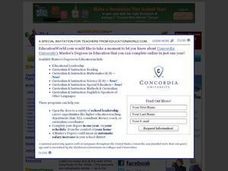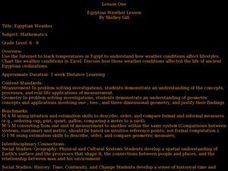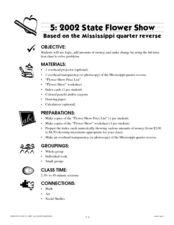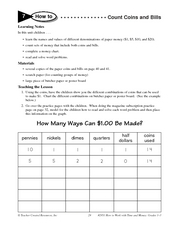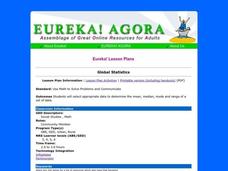Curated OER
Getting Ready to Become An Adult
Learners participate in a problem solving activity and discuss how effective their solution was. In this getting ready to become an adult instructional activity, students read Ta-ne-e-ka and use guiding questions to address the...
Curated OER
Team Problem-Solving Fun
Students work in groups to solve a variety of puzzling activities which include math, spelling, anagrams, and geography. They use cooperative skill to accomplish each task and chart their group progress.
Curated OER
Personal/Social Development: Conflict Busters
Middle schoolers examine the steps to problem-solving and apply them to real-life situations. They discuss the five-step problem-solving chart, observe and record conflicts for three days, and list and discuss how they would solve the...
Curated OER
Gold Rush California and its Diverse Population
Learners compare contemporary cultural differences with historical differences based on population percentage. In this cross-curriculum Gold Rush/math lesson, students analyze aspects of California's Gold Rush population and diversity...
Curated OER
Time Zones
Students solve time zone problems and chart travel around the world. In this time zone activity, students learn about the history of time zones and view a time zone map. Students use the time zone map to solve time zone...
Curated OER
Paper Bags Made From Trees
In this math and ecology activity, students read about the number of paper bags that can be made from a tree. Students fill out a chart in which the number of trees used to make paper bags for a week and a year is calculated for 5...
Curated OER
Summer Bridge Activities 4-5
In this cross-curricular worksheet, students complete various activities. They complete a crossword puzzle dealing with electricity, change mixed numbers into decimals, subtract fractions, identify adjectives in sentences, solve money...
Curated OER
Battling Bullies
Students identify aspects of a conflict situation through a story. They engage in problem solving or identification of an aspect of bullying. Applying their knowledge of bullying, they create scenarios that reflect their methods of...
Curated OER
Santa's List Sums (J3)
In this finding the sums worksheet, students view a chart of street names and numbers of boys and girls, add the total number of children on each street, the grand total number of children, and the total number of each sex. Students...
Curated OER
Santa's List Sums (I3)
For this finding the sums worksheet, student observe a chart of street names and numbers of boys and girls, add the number of children on each street, the grand total of children, and the total number of each sex. Students solve 20...
Curated OER
The Pilgrims
Learners use distance measuring tools to follow directions and chart the path the pilgrims made from Plymouth, England to Boston, Massachusetts. In this Pilgrim voyage lesson, students use a map to chart the distance traveled by the...
Curated OER
Egyptian Weather Lesson
Students chart temperatures in Egypt on spreadsheet to determine how weather conditions affect lifestyles.
Curated OER
Credit: Taking an Interest in Credit
Students examine how credit works but looking at how credit cards and interest rates work. They use percentages to solve problems using credit card interest rates while completing a worksheets.
Curated OER
Healthful Eating
Learners read a story about how cartoon characters are partially to blame for American's obesity problem, and answer vocabulary and comprehension questions about it. In this healthful eating lesson plan, students respond to literature by...
Curated OER
Junk Mail Overload!
Students discuss the "junk mail nuisance" with the teacher and share their opinions on the problem. Students collect a week's worth of junk mail, bring to class and complete a chart about the amount and weight. Students then complete an...
Curated OER
Math & Social Science
Students are given data and are to calculate averages and yearly totals of how many cars travel the Tacoma Narrows Bridge. They also make a graph of the data.
Education World
The African American Population in US History
How has the African American population changed over the years? Learners use charts, statistical data, and maps to see how populations in African American communities have changed since the 1860s. Activity modifications are included to...
Curated OER
2002 State Flower Show
Here is another State Quarter lesson. This one uses the Mississippi State Quarter. Pupils utilize beautifully-designed worksheets embedded in the plan, to practice calculating which combinations of flowers they can afford to buy. They...
Curated OER
MOBILITY, Traveling Lightly: What’s My Footprint?
Students calculate their carbon footprint. In this environmental technology lesson, students listen to a lecture on climate change. Students brainstorm solutions to reduce environmental impact based on travel options. Students calculate...
Curated OER
Atlatl Lessons
Fifth graders study math patterns and relationships as well as learn about the heritage of Aboriginal peoples of Saskatchewan. In this patterns and heritage lesson, 5th graders research the daily lives of First Nations People in...
Curated OER
How To: Count Coins and Bills
Students discover the names and values of different monetary denominations. In this money lesson, students examine the different combinations that money can be added in to find specified amounts. The students complete worksheets based on...
Curated OER
Exquisite Excursions
Students locate 6 cities, one on each of the 6 major continents. They find distance for each leg of their journey, convert to percents, use a time zone map, and convert to foreign currencies.
Curated OER
Global Statistics
Young scholars select appropriate data to determine the mean, median, mode and range of a set of data. They calculate the statistical data on literacy rates and life expectancy within each geographic region of the world. Students...
Curated OER
Pop Clock
Learners review the Census Bureau's Homepage, gather information regarding population trends in order to make predictions on future populations.



